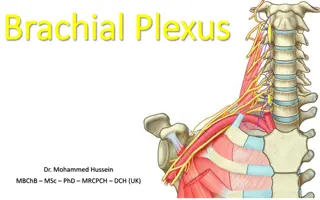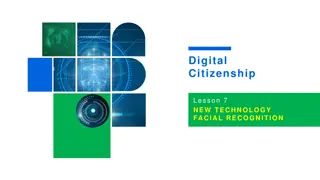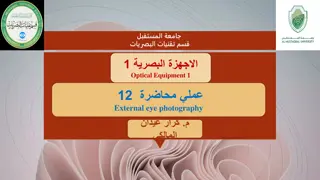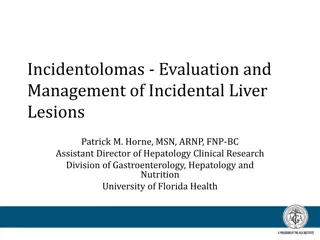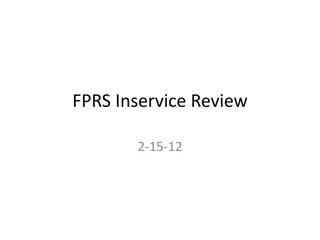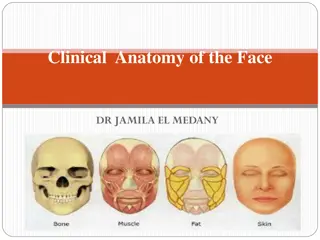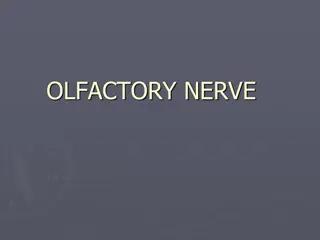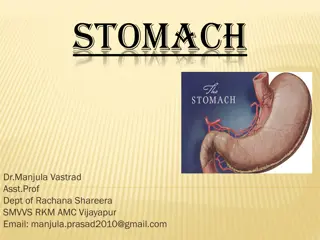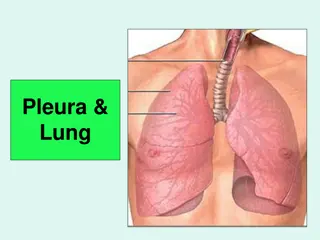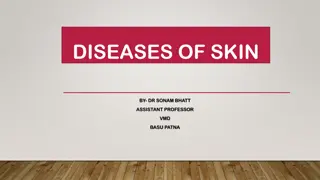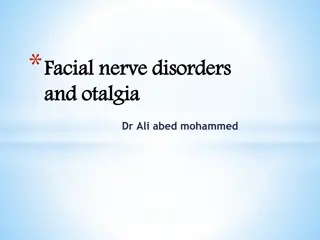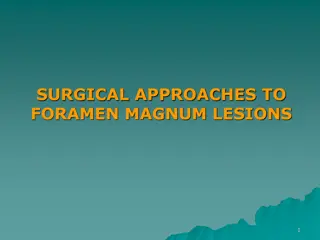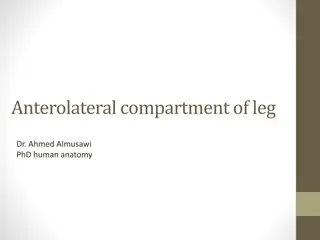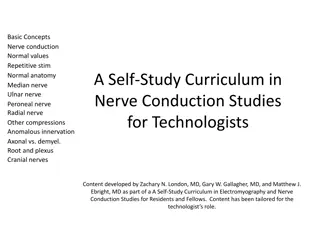Understanding Facial Nerve Lesions: Clinical Scenarios and Anatomy Overview
A comprehensive exploration of facial nerve lesions through real-life clinical scenarios and detailed anatomical insights. Dive into cases involving trauma, fractures, and abscesses to understand the varied manifestations of these lesions. Learn about the functions of the facial nerve, its segments, and distribution, enhancing your knowledge in this critical area of medicine.
Download Presentation

Please find below an Image/Link to download the presentation.
The content on the website is provided AS IS for your information and personal use only. It may not be sold, licensed, or shared on other websites without obtaining consent from the author. Download presentation by click this link. If you encounter any issues during the download, it is possible that the publisher has removed the file from their server.
E N D
Presentation Transcript
Test Your Knowledge! Dr Ooi Huah Chiang ACCS-EM ST3 Colchester General Hospital 30/9/2020
FRCEM Primary 180 Single-Best Answer Questions on applied basic science Blueprint: Anatomy x60 Physiology x60 Pharmacology x27 Microbiology x18 Pathology x9 EBM/Statistics x6
Q1 - A 23 year old male was brought in after sustaining a deep slash wound to his right preauricular area. You suspect transection of the facial nerve. Which function on the side of the injury is most likely to be preserved? A. Corneal reflex B. Puffing out the cheek C. Wrinkling the forehead D. Taste at anterior two-thirds of tongue E. Showing the teeth
Q2 - A 26 year old female was brought in after being struck in the head with a bat. CT head shows a fracture of the left temporal bone with collapse of the stylomastoid foramen. Which of the following functions is most likely to be spared? A. Corneal reflex B. Sensation of the external auditory meatus C. Lacrimation D. Voluntary swallowing E. Contraction of the posterior scalp
Q3 - A 23 year old male is admitted for high fevers and a left temporal headache. CT head shows a cerebral abscess obliterating the mastoid area of the left temporal bone. Which of the following facial nerve signs would you least expect to find on the side of the injury? A. Hyperacusis B. Loss of sensation at the external auditory meatus C. Loss of taste to the anterior tongue D. Impaired salivation E. Facial paralysis involving the forehead
Explanation Facial nerve (CN7) is the commonest cranial nerve lesion Its functions include: Lacrimation Stapedial reflex Taste sensation to anterior 2/3 of tongue + salivation Motor innervation of muscles of facial expression + corneal reflex Other minor functions Entire course of the facial nerve can be divided into 3 segments: Intracranial segment Intratemporal segment Extracranial segment Internal auditory meatus Stylomastoid foramen Image adapted from teachmeanatomy.info
Course and Distribution of CNVII Intracranial segment: Motor nucleus in the pons (decussates at pyramids) Superior salivatory nucleus in pons Nucleus tractus solitarius in medulla (taste) Exit each side of brainstem at the cerebellopontine angles with CN8 and enter the internal acoustic meatus (temporal bone entrance) Combine to form intermediate nerve
Course and Distribution of CNVII Intratemporal segment: Motor and intermediate nerves enter facial canal (Z-shaped) Combines to form geniculate ganglion, gives off superficial greater petrosal nerve (supplies lacrimal glands) Bends posteriorly (1st bend), continues to middle ear Makes 2nd bend at pyrimidal eminence and gives off nerve to stapedius (stapedial reflex = hyperacusis if lost) Enters mastoid and meets chorda tympani (taste and salivation from submandibular and submental glands) Immediately exits temporal bone through stylomastoid foramen
Course and Distribution of CNVII Extracranial segment After exiting stylomastoid foramen, gives off posterior auricular nerve (supplies sensation to external auditory meatus, and motor function to occipitalis which contracts posterior scalp) Enters parotid gland and gives off 5 terminal branches: Temporal Zygomatic Buccal Marginal mandibular Cervical
Q4 - You have accidentally cut your finger with a scalpel blade while preparing equipment for central venous access. You notice that the initial pain was instantaneous and so intense that you withdrew from the blade, but is later replaced by a duller, longer lasting pain. You recall that different pain fiber types are responsible for these 2 sensations. Which of the following contributes to the faster pain signal conduction? A. Higher amplitude of stimulus B. Higher frequency of stimulus C. Thinner myelination D. Larger axonal diameter E. Greater transmembrane potential
Explanation The two factors that increase conduction speed of neuronal action potential are: Greater axonal diameter Thicker myelination Higher frequency of stimuli increases signal intensity Achieving a transmembrane potential threshold causes depolarisation in an 'all or nothing' mechanism, but does not affect conduction velocity or intensity
Q5 - A 78year old lady sustained a laceration wound on her forearm after falling over in her bedroom. You notice that the bleeding has stopped with the paramedics' bandaging, and you reflect on the process of achieving haemostasis. Which factor is most important in primary haemostasis? A. von Willebrand factor B. Conversion of fibrinogen to fibrin C. Activation of prothrombin to thrombin D. Activation of protein C E. Protein S
Explanation Primary haemostasis refers to formation of platelet plug Factors involved in platelet activation/adhesion: von Willebrand factor Serotonin (5HT) Thromboxane A2 ADP receptors Glycoprotein IIb/IIIa Note: Secondary haemostasis refers to formation of fibrin plug ie coagulation cascade (basic understanding expected)
Q6 - You are treating a 64-year-old man with acute pulmonary oedema, and have decided to start a glyceryl trinitrate (GTN) infusion. Which effect of nitrates contributes most in this situation? A. Diuresis B. Arterial dilation C. Venodilation D. Greater ventricular contractility E. AV nodal inhibition
Explanation Nitrates cause both arterial and venous dilation, but mostly venodilation at therapeutic doses. This leads to reduced preload, reduced systemic and pulmonary vascular resistance, increased coronary blood flow and reduced overall workload of the heart.
Q7 - A 40-year-old male underwent a splenectomy following a traumatic splenic rupture. The discharge plan includes pneumococcal and meningococcal vaccinations. Which of the following explains pneumococcus's increased virulence in this patient? A. Polysaccharide capsule B. Motile flagella C. Surface protein A D. Lipopolysaccharide outer membrane E. Haemagglutinin attachment
Explanation The associated pathogens are: A. Polysaccharide capsule - Strep pneumonia (impairs opsonisation) B. Motile flagella - Cholera C. Surface protein A - Staph aureus D. Lipopolysaccharide outer membrane - Gram negative bacteria E. Haemagglutinin attachment - Influenza virus
Q8 - An 18-year-old female with cystic fibrosis presents with an intracerebral bleed. The cause is determined to be vitamin K deficiency. What is the main underlying pathophysiology? A. Malabsorption due to bile acid deficiency B. Malabsorption due to pancreatic duct blockage C. Malabsorption due to hepatic failure to synthesise bile D. Malabsorption due to ineffective chloride transport across intestinal mucosa E. Malabsorption due to rapid intestinal transit time
Explanation Pancreatic insufficiency is the leading cause of fat malabsorption and subsequent fat-soluble vitamin malabsorption among cystic fibrosis sufferers Impaired secretion of chloride and water in the pancreas causes increased acidity and thick secretions, leading to ductal obstruction and acinar cell destruction. Options A and C are contributory to some extent but not as much Option D mentions chloride ion transport but in the wrong location
Q9 - What factor most reduces external validity of a study? A. Absence of blinding B. Allocation bias C. Selection bias D. Confounding E. Small sample size
Explanation External validity refers to how generalisable the results are beyond the confines of the experiment. The main factor that would affect this is the population sampled. A study that narrowly limits its choice of participants (eg single centre, non-smokers only, limited age group, etc) would make the results less externally valid, even though such limits are beneficial in minimising confounders. Selection bias, where there is a skew of the sample population towards a specific trend, would thus most limit external validity.



